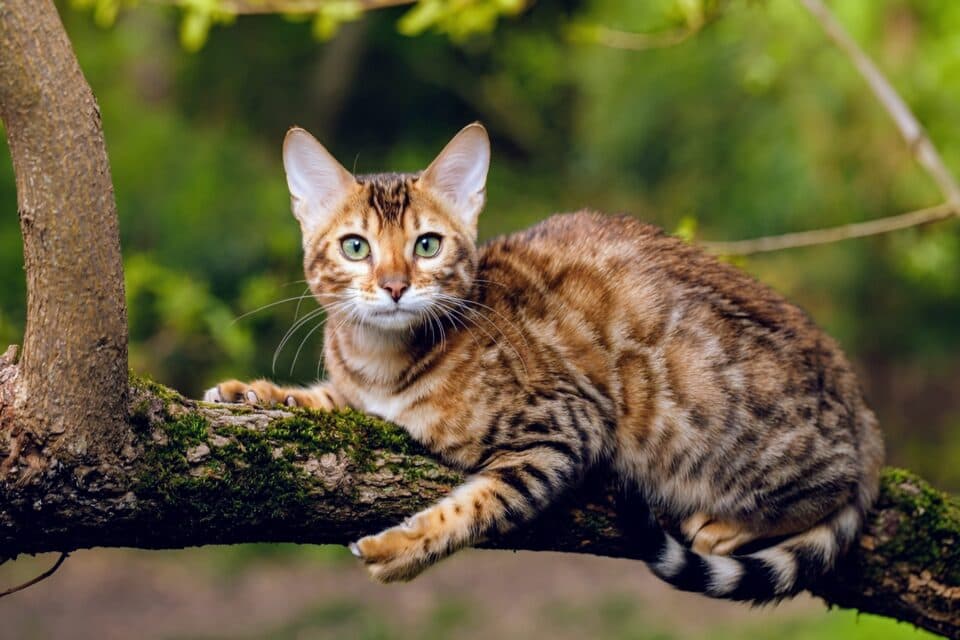
Bengal cats' wild appearance is surprisingly tied to domestic cats
A team of scientists led by Stanford University has traced the origins of the Bengal cat’s eye-catching coat to domestic cat genes selectively bred for their exotic appearance. It was previously assumed that the markings of the Bengal cat were linked to the wild genes of the Asian leopard cat.
The research suggests that the marbled and spotted patterns, as well as the iridescent sheen of Bengal cats, which make them resemble small jungle cats, are in fact the result of aggressive selection for certain domestic cat genes after initial breeding with wild cats.
Distinctive appearance of the Bengal cat
“Most of the DNA changes that underlie the unique appearance of the Bengal cat breed have always been present in domestic cats,” said study senior author Gregory Barsh, an emeritus professor of genetics, shedding light on the true genetic source of the Bengal cat’s distinctive look. “It was really the power of breeding that brought them out.”
With contributions from Bengal cat breeders, the study involved a detailed genetic analysis of nearly 1,000 Bengal cats over a period of 15 years. The findings not only illuminate the specific origins of the Bengal cat’s coat but also contribute to a broader understanding of how genetics encode appearance and how various genes interact to produce an array of colors, patterns, and physical traits.
A visually striking breed of cats
The initial breeding of wild Asian leopard cats with domestic cats, conducted by biologist Jean Mills from the 1960s through the 1980s, aimed to create a visually striking new breed.
Through successive generations, breeders selectively enhanced cats with desired physical attributes and temperaments, leading to the official recognition of the Bengal cat as a distinct breed by the International Cat Association in 1986.
Unique opportunity to explore genetic variation
While the experts’ previously identified genes responsible for coat color variations in tabby cats and unique markings in Abyssinian cats, research on Bengal cats represents a unique opportunity to explore genetic variation and its influence on form, color, and pattern.
“The big-picture question is how genetic variation leads to variation in appearance,” Barsh said.
“This is a question that has all kinds of implications for different species, but we think that cats offer an especially tractable way to study it.”
Challenging widespread assumptions
Surprisingly, the team’s genetic analysis of 947 Bengal cat genomes revealed that the breed’s exotic appearance did not directly inherit any specific parts of the Asian leopard cat genomes.
This finding challenged the widespread assumption among breeders and owners that the Bengal cat’s distinctive looks were derived from leopard cats. Instead, the study demonstrated that these aesthetic traits resulted from variations in genes already present in domestic cats.
The glitter effect in some Bengal cats
Furthermore, the scientists delved into the genetic basis of the “glitter” effect seen in about 60% of all Bengal cats, characterized by their exceptionally soft, gold-iridescent fur. This trait was linked to a mutation in the Fgfr2 gene, originating not from leopard cats but from domestic ones, and is nearly specific to Bengal cats.
This particular mutation uniquely reduces, rather than eliminates, the activity of the protein encoded by Fgfr2, offering insights into how gene variations can subtly influence appearance.
Charcoal Bengal cats
Additionally, the team investigated the genetics behind “charcoal” Bengals, a subset with darker coloring, uncovering a leopard cat gene related to the charcoal color. However, this gene only led to the charcoal appearance when combined with domestic cat genomes, an instance of genomic incompatibility illustrating the complex interplay between genes of distantly related species within hybrid animals.
“Hybridization between different species can happen naturally and is responsible for the small amount of Neanderthal DNA found in many human genomes. But the wild leopard cat and the domestic cat are more different from each other than humans are from chimpanzees, and it’s remarkable to see how DNA from these distantly related species can exist and work together in a popular companion animal,” Barsh explained.
More refined breeding strategies
These findings enrich breeders’ understanding, enabling more refined breeding strategies for new colors and patterns, while highlighting the potency of artificial selection.
“Breeders are extremely interested in our data,” said lead author Christopher Kaelin, a professor of genetics at Stanford. “They not only want to contribute their cats’ DNA but they also want to be involved and help analyze data and hear about our results. It’s been a great collaboration and a true example of citizen science.”
This study, published in the journal Current Biology, offers both valuable information for cat lovers and for scientists interested in processes such as hybridization and selection.
“Human DNA of European or Asian ancestry contains a small fraction of Neanderthal DNA that was caused by hybridization between the two species after humans migrated out of Africa. In some ways, Bengal cats are similar, except the distance between the two hybridizing species is much greater and the time since hybridization is much less,” Barsh concluded.
—–
Like what you read? Subscribe to our newsletter for engaging articles, exclusive content, and the latest updates.
Check us out on EarthSnap, a free app brought to you by Eric Ralls and Earth.com.
—–












